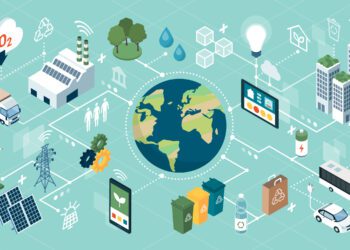With many companies continuing to offer flexible work locations, the impact of hybrid and remote workers has become a key part of measuring a company’s emissions.
Global emissions fell by a record amount in 2020. And while the pandemic lockdowns that drove that drop were temporary — U.S. greenhouse gas emissions increased 1.3% in 2022, led by buildings, industry, and transportation — it raised one of the biggest unresolved questions for companies looking to reduce their carbon footprint: How much greener can they become simply by having fewer employees commuting into offices every day?
With many companies continuing to offer flexible work locations even as more employees begin to trickle back into offices, the impact of hybrid and remote workers has become a key part of measuring a company’s emissions.
Salesforce, for example, is continuing to allow people to work from home or adopt a hybrid work model. That strategy will reduce emissions per employee by 29%, according to the company’s 2021 “Decarbonizing a Work From Anywhere World” report, which outlines its climate action plan to reach net zero. That includes measuring employees’ at-home energy usage.
“While home emissions will increase due to the additional energy required to support remote work, reductions in office energy emissions and commute emissions outweigh anticipated home increases,” the report stated.
There’s an argument to be made both for and against the environmental benefits of remote work. Newer or retrofitted office buildings may supply cleaner energy than homes by using renewable energy sources, such as solar and wind. They also may implement greener practices than we typically see in homes, such as using recycled water. Conversely, before the pandemic, people spent an average total of 55 minutes commuting to and from work every day. That’s one reason transportation accounted for 27% of greenhouse gases emitted in the U.S. in 2020.
“I think what we need to figure out is not just the direct savings on emissions – it’s also the indirect savings and changes in how we do things,” said Ofer Ben-Dov, sustainability practice lead at Traction on Demand, North America’s largest dedicated Salesforce consulting and application development firm. “Because it’s not just, ‘I’m working at home instead of just driving.’ Many will still drive because they need to get to a factory, for example, to work in a production line. They will still commute, but they will emit way less because there are fewer people on the road and less traffic overall. So there are other effects in the general economy that are rolling behind this change that are difficult to account for.”
Measuring employee emissions
Over the last year, sustainability managers have worked to track the impact of working from home and hybrid work and continue to come up with new methodologies. According to Katie Bachman, director of sustainability accounting at Stok, a San Francisco-based sustainability consulting firm, companies can track employee emissions in three ways:
- Make calculations based on employee location and average energy consumption.
- Conduct surveys to determine actual employee energy use at their homes.
- Do an audit of which electronics each employee uses to roughly determine power draw.
While corporate sustainability teams were aware of remote work’s impact on the overall carbon footprint before the pandemic, it wasn’t a big factor in emissions reporting. Only 8% of the global workforce permanently worked from home before the pandemic. However, over the last two years, Bachman said remote work soared to become the most important emissions factor companies needed to pay attention to.
“If you’re not factoring in the electricity I’m using as an employee to do business,” Bachman said, “you’re not really [calculating] the full scope of your emissions.”
It’s not realistic to go door-to-door to do an energy audit at each employee’s home, but there are tools companies can use to measure and gain better insight into how remote employees impact overall emissions. You can use various calculators and input information like commute times, types of energy used, and times when more energy is consumed. You can also do an overall audit to understand, manage, and report emissions. Salesforce’s Net Zero Cloud uses data analytics to help companies track their carbon footprint.
“Net Zero Cloud is a carbon accounting, tracking, and forecasting platform that can integrate these measurements and help companies plan,” said Boris Gamazaychikov, manager, emissions reduction at Salesforce. “A lot of companies are starting to estimate [home energy usage], but this is a new thing to include those carbon emissions within your company footprint.”
Corporate sustainability at home
In a perfect world, everyone’s remote work setup would include solar panels, green energy, recycling, composting, and energy-efficient appliances and electronics. But a company can’t force its employees to spend thousands of dollars to overhaul their homes or even report their usage. They can, however, offer benefits and incentives to help create a greener space.
To start, it’s about educating employees on what they can do to live more efficiently at home, whether that’s installing energy-efficient lighting and appliances like washing machines, refrigerators, or even a smart thermostat; installing a home energy monitoring system like Sense; or offering company subsidies to purchase clean energy through local utility companies, to install solar panels, or to purchase electric vehicles for a cleaner commute.
“We’re going to start to see those types of benefits, especially for 100% remote or permanent hybrid remote workers, be rolled out as companies have to start being accountable for that carbon impact,” Bachman said. “They need to find a way to reduce it.”
Courtesy SalesForce. By Ari Bendersky. Article available here.












